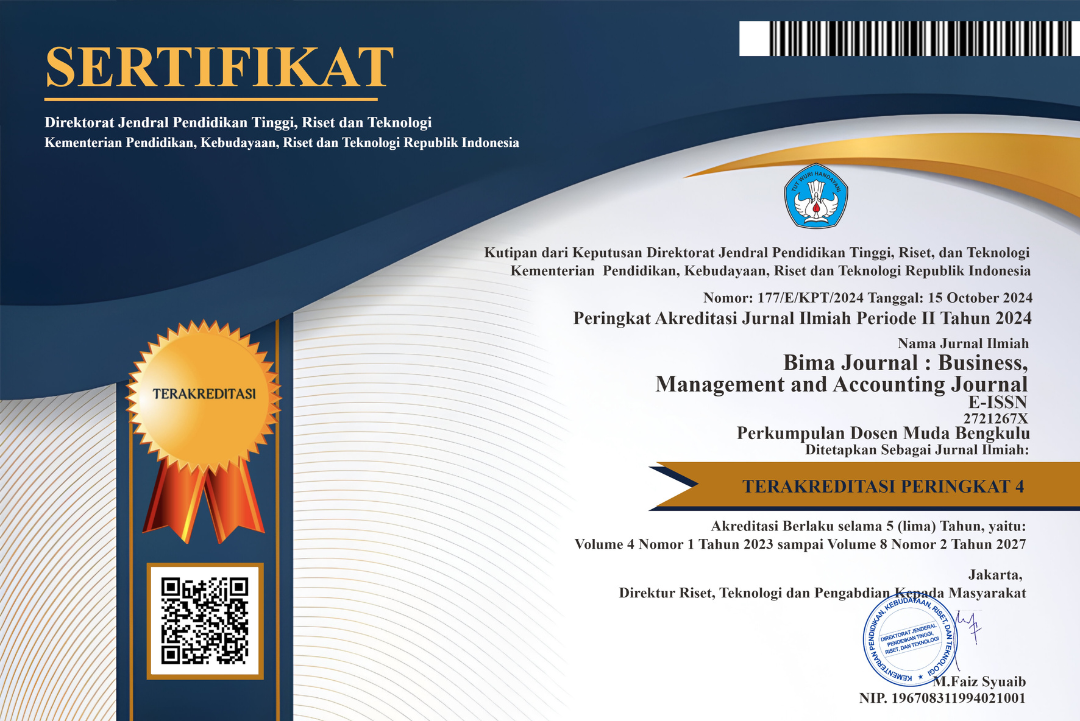Impact of Halal Awareness On Intention Toward Halal Tourism: A Study On Generation Z Muslims In Bengkulu
DOI:
https://doi.org/10.37638/bima.5.2.141-150Abstract
Purpose: Identify the key factors influencing the travel intentions of Generation Z Muslims in Bengkulu to visit halal tourism destinations, using the Theory of Planned Behavior (TPB) model approach. The study targeted Generation Z Muslims residing in Bengkulu Province, with respondents selected through purposive sampling. Results: Indicate that the intention to visit halal tourist destinations is significantly influenced by factors such as attitudes, perceived behavioral control, subjective norms, and halal awareness. All of these independent factors were found to have a positive effect on travel intentions. Findings: Provide valuable insights for stakeholders in the tourism industry, especially in developing halal tourism products and services that cater to the specific preferences and needs of Generation Z Muslims. Originality : While TPB has been used in past studies, applying it to the context of halal tourism for Generation Z Muslims in Bengkulu is unique. The emphasis on halal awareness as a key influencing factor adds an innovative layer to the existing framework. These results can contribute to enhancing the marketing strategies of halal tourism destinations, ensuring their appeal to this demographic group. Conclussions: Attitude, perceived behavioral control, subjective norms, and halal awareness all significantly influence the intention of Generation Z Muslims to visit halal tourism destinations. Type of Paper : Empirical Research Article
References
Ajzen, I. (1991), “Theory of planned behavior”, Organization Behavior and Human Decision Process, Vol. 50, pp. 179-211.
Alam, S. S & Sayuti. 2011. Applying the theory of Planned Behavior (TPB) in halal food purchasing. International Journal of Commerce and Management, 1:8-20.
Amadeus Traveller Trend Observatory. (2016). Halal Travellers 2016. In Amadeus-commissioned report conducted by Context Consulting (pp. 1–21). Madrid.https://amadeus.com/documents/en/retail-travel-agencies/research-report/halal-travel-report-2016.pdf. Diakses pada 10 Oktober 2024
Azzahra, S. (2019). Pariwisata Tempat Tadabbur, Bukan Maksiat!. https://www.remajaperubahan.com/2019/03/pariwisata-tempat-tadabbur-bukan-maksiat.html . Diakses pada 12 Oktober 2024.
Badan Pusat Statistik (2020). Jumlah Penduduk Indonesia Tahun 2020.
https://sensus.bps.go.id/main/index/sp2020#:~:text=Jumlah%20penduduk%20Indonesia%20pada%20tahun%202020%20adalah%20sebanyak%20270.203.917%20jiwa. diakses pada 18 Oktober 2024
Bashir, A. M. (2019). Halal Tourism: Emerging Opportunities. Tourism Management Perspectives, 31, 138–144.
Bayu, D. A. ., & Yudhistira, A. W. . (2021). Indonesia Didominasi Milenial dan Generasi Z Aria W. Yudhistira. https://katadata.co.id/infografik/6014cb89a6eb7/indonesia-didominasi-milenial-dan-generasi-z. Diakses pada 02 Oktober 2024
Cahyadi, H., Agustina, T., & Arief, S. (2020). The Influence of Attitudes on Halal Tourism Intention. Journal of Environmental Management & Tourism, 11(3), 455-468.
El-Gohary, H. (2016), “Halal tourism, is it really Halal?”, Tourism Management Perspectives, Vol. 19, pp. 124-130.
Fitria, M. R., Aji, H., and Heryawan, A. Y. 2019. The Effect of Halal Awareness, Halal Certification, and Marketing Toward Halal Purchase Intention of Fast Food Among Muslim Millenials Generation.Russian Journal of Agricultural and Socio-EconomicSciences, 90(6), 76–83.
Guerin, R. J., & Toland, M. D. (2020). An application of a modified theory of planned behavior model to investigate adolescents’ job safety knowledge, norms, attitude and intention to enact workplace safety and health skills. Journal of Safety Research, 72, 189–198.
Hair, J.F. Jr, Anderson, R.E. and Black, W.C. (1998), Multivariate Data Analysis, Prentice-Hall, Upper Saddle River, NJ, pp. 233-40.
Han, H., Yu, J., & Kim, W. (2018). Youth travelers and waste reduction behaviors while traveling to tourist destinations. Journal of Travel & Tourism Marketing, 35(9), 1119–1131.
Hanafiah, M. H., & Hamdan, N. A. (2020). Determinants of Muslim Travelers’ Halal Food Consumption Attitude and Behavioral Intentions. Journal of Islamic Marketing, 11(1), 105–120.
Haque, A., Sarwar, A., Yasmin, F., Tarofder, A. K., & Hossain, M. A. (2019). Non-Muslim Consumers’ Perception Toward Purchasing Halal Food Products in Malaysia. Journal of Islamic Marketing, 10(3), 874–890.
Kartono, R., & Tjahjadi, J. K. (2021). Investigating Factors Affecting Consumers’ Intentions to Use Online Food Delivery Services During Coronavirus (COVID-19) Outbreak in Jabodetabek Area. The Winners, 22(1), 1–14.
Khalek, A. A. and Ismail, S. H. S. (2015), “Why are we eating halal – Using the theory of planned behavior in predicting halal food consumption among Generation Y in Malaysia”, International Journal of Social Science and Humanity, Vol. 5, No. 7, pp. 608-612.
Kleinbaum, D.G., Kupper, L.L. and Muller, K.E. (1988), Applied Regression Analysis and Other Multivariate Methods, PWS, Boston, MA.
Majid, M. B., Sabir, I., and Ashraf, T. 2015. ConsumerPurchase Intention towards Halal Cosmetics and Personal Care Products in Pakistan. Global of Research in Business and Management, 1(1), 45–53.
Nurhasanah, S. and Hariyani, H. F. 2017. Halal PurchaseIntention on Processed Food. Tazkia Islamic Fi-nance and Business Review, 11(2), 187–209.
Rahman, M., Moghavvemi, S., Thirumoorthi, T. & Rahman, M.K. (2020). The impact of tourists’ perceptions on halal tourism destination: a structural model analysis. Tourism Review, Vol. 75 No. 3, pp. 575-594.
Setyaningsih, E. D. and Marwansyah, S. 2019. The Effect of Halal Certification and Halal Awarenessthrough Interest in Decisions on Buying Halal Food Products. Journal of IslamicEconomics, Finance, and Banking, 3(1), 64–79.
Sudarsono, H., Wibowo, T., & Effendi, N. (2021). The Impact of Halal Awareness and Attitudes on the Intention to Visit Halal Tourism Destinations. Journal of Environmental Management & Tourism, 12(6), 1529–1541.
Syahirah, N., & Mohammed, S. (2016). Religiosity as a Moderator in the Effect of Subjective Norms on Intention to Visit Halal Tourism Destinations. Journal of Tourism Management Research, 8(2), 127–135.
Wang, S. and Fu, Y. Y. (2015), “Applications of planned behavior and place image to visit intentions: A casino gaming context”, Advances in Hospitality and Leisure, Vol. 11, pp. 67-87.
Wang, Y. (2014), “Consumers' purchase intentions of shoes: Theory of planned behavior and desired attributes”, International Journal of Marketing Studies, Vol. 6, No. 4, pp. 50-58.
Widyaningrum, P. W. 2019. Pengaruh Label Halal, Kesadaran Halal, Iklan, dan Celebrity Endorserterhadap Minat Pembelian kosmetik melaluivariabel Persepsi sebagai Mediasi (Studi PadaCivitas Akademika Universitas MuhammadiyahPonorogo). Capital: Jurnal Ekonomi Dan Manajemen, 2(2), 74
Widyaningrum, P. W. 2019. Pengaruh Label Halal, Kesadaran Halal, Iklan, dan Celebrity Endorserterhadap Minat Pembelian kosmetik melaluivariabel Persepsi sebagai Mediasi (Studi PadaCivitas Akademika Universitas MuhammadiyahPonorogo). Capital: Jurnal Ekonomi Dan Manajemen, 2(2), 74
Wulandari, N. (2022). Generasi Z Si Paling Healing. http://upbk.unp.ac.id/news/read/54/generasi-z-si-paling-healing. Diakses pada 12 Oktober 2024.
Downloads
Additional Files
Published
Issue
Section
License
An author who publishes in the BIMA JOURNAL: Business, Management, and Accounting Journal agrees to the following terms:
Author retains the copyright and grants the journal the right of first publication of the work simultaneously licensed under the Creative Commons Attribution-ShareAlike 4.0 License that allows others to share the work with an acknowledgement of the work's authorship and initial publication in this journal
Submission of a manuscript implies that the submitted work has not been published before (except as part of a thesis or report, or abstract); that it is not under consideration for publication elsewhere; that its publication has been approved by all co-authors. If and when the manuscript is accepted for publication, the author(s) still hold the copyright and retain publishing rights without restrictions. For the new invention, authors are suggested to manage its patent before published. The license type is CC-BY-SA 4.0.
BIMA JOURNAL: Business, Management and Accounting is licensed under a Creative Commons Attribution-ShareAlike 4.0 International License.
You are free to:
Share — copy and redistribute the material in any medium or format
Adapt — remix, transform, and build upon the material
for any purpose, even commercially.
The licensor cannot revoke these freedoms as long as you follow the license terms.
Under the following terms:
Attribution — You must give appropriate credit, provide a link to the license, and indicate if changes were made. You may do so in any reasonable manner, but not in any way that suggests the licensor endorses you or your use.
ShareAlike — If you remix, transform, or build upon the material, you must distribute your contributions under the same license as the original.
- No additional restrictions — You may not apply legal terms or technological measures that legally restrict others from doing anything the license permits.
Notices:
- You do not have to comply with the license for elements of the material in the public domain or where your use is permitted by an applicable exception or limitation.
- No warranties are given. The license may not give you all of the permissions necessary for your intended use. For example, other rights such as publicity, privacy, or moral rights may limit how you use the material.





















